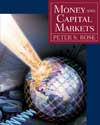 |  Money and Capital Markets: Financial Institutions and Instruments in a Global Marketplace, 8/e Peter Rose,
Texas A & M University
Marketability, Default Risk, Call Privileges, Prepayment Risk, Taxes, and Other Factors Affecting Interest Rates and Asset Prices
Standard & Poor's QuestionsChapter 8 in Money and Capital Markets: Marketability, Default Risk, Call Privileges, Prepayment Risk, Taxes, and Other Factors Affecting Interest Rates and Asset Prices
Question 1
Which financial firms in Market Insight would be likely to have high tax liability exposure? How could you measure this? Which firms seem to be the most effective tax managers?
Question 2
Capital One Financial Corporation (COF) and Providian Financial Corp (PVN) are two leading consumer finance and credit-card companies who are in close competition with one another, but have different default-risk (credit) ratings. Does financial theory seem to hold here? Is the right firm given the highest credit rating? Should the riskiest firm pay more for borrowed funds than the less risky of these two companies? Why?
Question 3
Chapter 8 focuses upon the problem of event risk and its links to a business’s financial performance and value. What "event" impacted WorldCom, the second largest long-distance phone carrier in the United States, toward the close of June 2002? What was the effect on this firm's stock price as reflected in S&P’s Market Insight and why?
Question 4
Five airlines listed on Market Insight—American, Continental, Delta, Northwest, and United--all had their credit ratings lowered by Standard & Poor’s Rating Service in June 2002, while U.S. Airways Group also experienced a further credit rating drop at the hands of Moody’s Investors Service. What, in theory, should happen to the stock prices and borrowing costs of these firms? According to the data and news reports provided by Market Insight and other information sources what actually happened to the equity values of these companies in the wake of their credit downgrades? Why might the stock prices of these firms not always behave in the way financial theory might suggest?
 <a onClick="window.open('/olcweb/cgi/pluginpop.cgi?it=gif:: ::/sites/dl/free/0072486767/54618/go_to_mi.gif','popWin', 'width=NaN,height=NaN,resizable,scrollbars');" href="#"><img valign="absmiddle" height="16" width="16" border="0" src="/olcweb/styles/shared/linkicons/image.gif"> (1.0K)</a> <a onClick="window.open('/olcweb/cgi/pluginpop.cgi?it=gif:: ::/sites/dl/free/0072486767/54618/go_to_mi.gif','popWin', 'width=NaN,height=NaN,resizable,scrollbars');" href="#"><img valign="absmiddle" height="16" width="16" border="0" src="/olcweb/styles/shared/linkicons/image.gif"> (1.0K)</a> |
|




 2003 McGraw-Hill Higher Education
2003 McGraw-Hill Higher Education